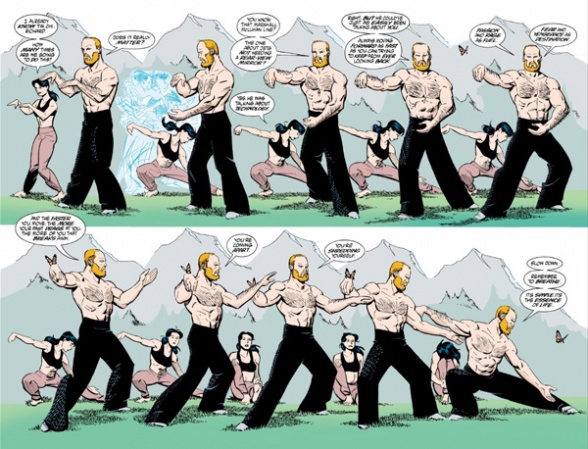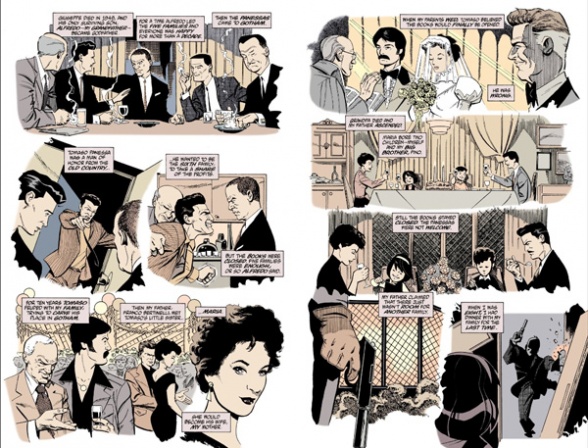Following Huntress’s big screen debut in Birds of Prey (and the Fantabulous Emancipation of One Harley Quinn), I was keen to revisit Greg Rucka and Rick Burchett’s 2000 miniseries “Batman/Huntress: Cry for Blood,” as I felt it could’ve been the basis for a great sequel if Ben Affleck hadn’t hung up the cape and cowl. It was one of the comics that endeared the character of Helena Bertinelli to me – so how well does it hold up?
Written by Greg Rucka#1 cover by
Rick Burchett
Art by Rick Burchett
Inks by Terry Beatty
Colored by Tatjana Wood
Separations by Jamison
Lettered by Clem RobinsAfter the Huntress, a vigilante with extreme methods, finally earns the approval of Batman, a mafia capo is suddenly discovered murdered by a crossbow, her weapon of choice. Now as Helena Bertinelli, aided by the mysterious Question, attempts to evade Batman and his allies, she must also prove her innocence and determine who is trying to frame her. Through this adventure we discover how watching her father, a powerful mafia leader, and the rest of her family be murdered, transformed this innocent Catholic girl into a nocturnal figure of vengeance.
The new millennium was a fascinating time for the Gotham books, with Greg Rucka and Ed Brubaker respectively heading the “Detective Comics” and “Batman” creative teams in the wake of 1999’s mammoth crossover ‘No Man’s Land.’ This series feels like a natural companion to Rucka’s ‘New Gotham’ run, building on Batman and Huntress’s difficult working relationship in the year-long crossover, as well as other Bat Family members like Nightwing, Tim Drake/Robin, and Oracle. One joy in revisiting this era is in seeing how much smaller Batman’s inner circle used to be – before Kate Kane, before Harper Row, before Damian and Duke – and realizing Helena used to be the “difficult” child before Jason Todd returned. (One priceless moment has Vic Sage point out Bats is basically the father Helena never had to rebel against.)

Rucka remains one of comics’ most engaging writers: he was still new on the scene here, but his background in prose presumably helped him pen a confident and compelling voice for Helena, whose narration could’ve been trite and tedious in the hands of a less competent writer. Here, you’re pretty much hanging onto her every word, fascinated by what she tells you about the history of the Mafia in Gotham, and her insights into Sicilian culture, including the true meaning of the word “omertà” (or at least, how she interprets it) – you could really tell Rucka was a novelist with Helena’s dramatic ruminations on these topics.
The art and inks are simple and stylish, recalling Batman: The Animated Series without becoming as cartoonish: one of the things I most appreciate about Burchett’s art is that while he does draw Helena like an old school pin-up, he also renders her with realistic abs, meaning the stylized designs don’t clash with the gritty story.

Wood’s muted coloring is the book’s most distinctive element, lending it the feeling it was a landmark comic published in the late ’80s (ala ‘Batman: Year One’), rather than the late ’90s. The flashbacks have even less colors, recalling Rucka’s “Detective” run at the time – the decision to render the flashback montages without panels was also absolutely fantastic, enhancing the sense of a hazy stream of consciousness.
Where the comic falters is in its disappointing ending. Conceptually, it’s perfectly in line with the influence from pessimistic ’70s crime films like The Godfather and Dirty Harry, a DC Comics version of which Rucka was clearly aiming for, but it feels at odds with the story until then. “Cry for Blood” is essentially Huntress’s ‘Knightfall,’ a story where the hero is completely broken physically and emotionally, and reemerges all the better for it, but Rucka serves up a third act twist in Helena’s origin that forces her to make a morally murky and upsetting decision.

The tragic turn of events are easier to swallow when you remember (like I did when I first read it) that it’s not the end of Helena’s story, and that this arguably set the stage for her joining the Birds of Prey in Gail Simone’s run a few years later. Still, for someone who only wants to check out one comic with Huntress after the movie, this isn’t the best pick: better to recommend a comic starring her before or after it was published, like ‘No Man’s Land’ or “Birds of Prey.”
For anyone else able to afford more time and money though, this is a curiosity definitely worth seeking out: it’s a mature, nostalgic window into a more classical DC era, with smart dialogue, distinctive art, and movie homages galore. Not all recognizable comic book heroes land a definitive solo comic that holds up, and Huntress was certainly lucky enough to receive one with a great creative team that remains exciting, memorable and haunting twenty years later. Hopefully, she will again sometime soon.







